/home/virtual/kjpt/journal//../xmls/kjpt-54-1-31.xml
KANG, LEE, JI, and SON: Re-identification of herbarium specimens through a morphological analysis reveals two species of Murdannia (Commelinaceae) from South Korea
Abstract
The previously reported alien plant Murdannia nudiflora is known to be distributed on Jejudo Island and in inland areas of South Korea. However, the species distributed in the Jejudo Island region exhibits differences in the morphology of the stems, leaves, and seeds compared to those in inland areas. Although M. loriformis is morphologically similar to M. nudiflora, it differs in terms of the development of the main stem, the formation of rosettes, and the occurrence of inflorescences that develop from branched stems. The seed testa of M. loriformis exhibits a radiating striated pattern and is not verrucose. Through the re-identification of specimens of M. nudiflora and an examination of individuals and images collected in areas of their distribution, it was determined that the individuals in the Jejudo region are M. loriformis, whereas those distributed inland were found to be M. nudiflora. This study presents revised descriptions and a taxonomic key for both species, with new Korean names designated based on the characteristics of the distribution areas and surrounding growth environments.
Keywords: Jejudo Island, Murdannia loriformis, Murdannia nudiflora, new record
INTRODUCTION
Murdannia Royle is a major genus within the Commelinaceae family belonging to the subfamily Commelinoideae and tribe Commelineae that is closely related to the genus Aneilema R. Br. ( Pellegrini et al., 2016). Approximately 60 taxa of Murdannia are distributed worldwide in tropical and subtropical climate regions, with particularly high morphological diversity observed on the Asian continent ( Ancy, 2014; Pellegrini et al., 2016). Previously, Murdannia species were classified as Commelina L. or Aneilema ( Ancy, 2014; Pellegrini et al., 2016). Murdannia plants exhibit a morphology similar to that of these two genera, though differences in the structure and morphology of flowers and fruits are distinct ( Brenan, 1952, 1966; Faden, 1998; Ancy, 2014; Pellegrini et al., 2016). Notable differences include the following: petals sessile, equal to subequal; stamen 3, antesepalous; staminodes 3, antepetalous, antherodes 3-lobed; capsules 3-valved ( Brenan, 1952, 1966; Faden, 1998; Ancy, 2014; Pellegrini et al., 2016; Kang et al., 2023).
In South Korea, only one species of Murdannia, M. keisak (Hassk.) Hand-Mazz, has been recorded ( Lee, 2007; Korea National Arboretum, 2023b). However, in 2023, M. nudiflora (L.) Brenan was reported as an alien species ( Kang et al., 2023; Korea National Arboretum, 2023a). Therefore, two taxa are currently present in South Korea. Although M. nudiflora was initially found on Jejudo Island, recent survey findings indicate the presence of this species in other regions, such as Andong-si, Daejeon-si, and Yeoju-si.
Murdannia nudiflora has occasionally been misidentified as M. loriformis (Hassk.) R. S. Rao & Kammathy owing to their morphological similarities ( Sulaiman et al., 2021). These two species share the characteristic of having caducous bracteoles and multiple flowers on an inflorescence, in contrast to M. keisak, which typically has persistent bracteoles and bears only a single flower ( Hong and DeFilipps, 2000; Ancy, 2014; Fukuoka and Iwatsuki, 2016; Kang et al., 2023). Recently, a Commelinaceae researcher suggested the need for a re-identification of the taxon known as M. nudiflora in Korea. Upon re-identification of all voucher specimens, we confirmed the presence of both M. nudiflora and M. loriformis in Korea.
In the present study, we present a report on the newly discovered alien plant M. loriformis. This paper includes a revised description of M. nudiflora, a taxonomic key for Murdannia, and information about the distributions of these two species. The results here are expected to provide fundamental information for the accurate identification of Murdannia spp. in Korea.
MATERIALS AND METHODS
We studied relevant literature and specimens to ensure a precise identification and a detailed description of relevant species ( Hong and DeFilipps, 2000; Ramana et al., 2013; Ancy, 2014; Nakamura, 2015; Fukuoka and Iwatsuki 2016; Kang et al., 2023). We observed and re-identified the specimens deposited at the Korea National Arboretum Herbarium (KH) and the National Science Museum Korea (NSMK) to determine the taxonomic identity of the specimens reported by Kang et al. (2023) for M. nudiflora. Furthermore, using GPS information on the specimens, we collected and identified individuals identified as M. loriformis or M. nudiflora. The morphologies of these individuals were observed and compared with those of the herbarium specimens. The seed morphological traits in the investigated species were observed under a stereomicroscope (Stemi 508, Zeiss, Oberkochen, Germany). Their morphological characteristics were measured using a digital Vernier caliper (Mitutoyo 500-196-30 absolute digimatic Vernier caliper, Tokyo, Japan). All plants used for the observation were preserved as dried specimens and were deposited at the Korea National Arboretum Herbarium.
RESULTS
Murdannia loriformis (Hassk.) R. S. Rao & Kammathy, Bull. Bot. Surv. India 3: 393, 1962.—TYPE: Indonesia. Java, s.die, Junghuhn s.n. (lectotype: L 0041700 Photo!, designated by Ancy et al., 2015). ( Figs. 1, 2).
Aneilema loriforme Hassk., Pl. Jungh. [Miquel] 2: 143, 1852.
Korean name: 우영사마귀풀(U-yeong-sa-ma-gwi-pul).
English name: Severalflower dewflower.
Herbs perennial. Roots rhizomes absent, fibrous, roots at the nodes. Stems diffused, main stem developed with rosette leaves, erect to decumbent, branched laterally with decumbent stems, glabrous. Leaves alternate, sessile, basal leaves rosetted; sheath glabrous, ciliate; leaf blade oblong-linear to lanceolate-linear, 2.5–7.3 cm long, 0.4–1.5 cm wide, apex acute, base rounded, margin entire, scabrous, usually undulate, glabrous, ciliate. Inflorescence cincinnus, axillary, or terminal on branched stems, solitary, rarely paired terminally; bract leaf-like; bracteoles caducous; more than 1 flower. Flowers zygomorphic, andromonoecious; sepal 3, ovate to elliptic, 1.5– 3.0 mm long, 1.3–1.4 mm wide, pale green, glabrous; petal 3, ovate, 5.1–7.4 mm long, 4.8–5.7 mm wide, white to pale pink; stamen 2, antesepalous, dorsifixed, filaments white to pale pink, base stouter, densely bearded with white to pale pink, anthers blue or purple, pollen white to pale yellow; staminode 3, antepetalous, filaments white to pale pink, densely bearded with white to pale pink, hair, antherodes 3-lobed, white to pale yellow; pistil 1, ovary elliptic, style curved, glabrous. Fruits capsule, ovate, 3.2–3.8 mm long, 2.3–3 mm wide, valves 3, seeds 2 per valve. Seeds oblong to elliptic, 1.2–1.3 mm long, 1–1.1 mm wide, pale brown; testa foveolate-reticulate, striate, verrucose appearance absent.
Flowering and fruiting: June–November.
Origin: Asia (Bangladesh, China, India, Japan, New Guinea, Philippines, Sri Lanka, Taiwan, Thailand, Tibet, Vietnam) ( POWO, 2023).
Distribution: Bangladesh, China, India, Japan, New Guinea, Philippines, Sri Lanka, Taiwan, Thailand, Tibet, Vietnam, South Korea ( POWO, 2023).
Distribution in South Korea: Jejudo Island (Jeju-si).
Specimens examined: USA. Florida: Miami-Dade, 26 Apr 1974, G. N. Avery 1495 (USF 117900).
JAPAN. Ryukyu: Okinawa, 30 Mar 2002, K. Yasuda 326 (L 3756609). Osaka: Nakanoshima Island, 9 Oct 2019, E. Suzuki s.n. (KAG 022546).
INDIA. Coimbatore: Tamilnadu, 20 Aug 2016, M. D. Nandikar 1262 (NGCPR 00090, 00091, 00105, 00111).
VIETNAM. Ninh Binh: Nho Quan, 9 Oct 1999, N. M. Cuong, D. T. Kien, M. V. Sinh 613 (L 1427212); 17 Nov 2005, M. V. Xinh 730 (L 4310314).
KOREA. Jeju-do: Jeju-si, Hankyung-myeon, Yongsu-ri, 15 Jun 2022, S. G. Lee Yongsuri220615-1, Yongsuri220615- 1 (KH 3000116, 3000117); 12 Oct 2023, E. S. Kang and Y. K. Joung Yongsuri231012-001, Yongsuri231012-002, Yongsuri231012-003, Yongsuri231012-004 (KH); 7 Nov 2023, H. J. Jo, Y. S. Kim, E. S. Kang and S. R. Lee Yongsuri231107-001, Yongsuri 231107-002, Yongsuri231107-003 (KH).
Murdannia nudiflora (L.) Brenan, Kew Bull. 7: 189, 1952.—TYPE: India. s.loc., s.die, Osbeck s.n. (lectotype: LINN 65.12 Photo!, designated by Merrill and Dandy, 1937) ( Figs. 3, 4).
Commelina nudiflora L., Sp. Pl.: 41, 1753; Aneilema nudiflorum (L.) Sweet, Hort. Br.: 430, 1826; Ditelesia nudiflora (L.) Raf., Fl. Tellur. 3: 69, 1837; Phaeneilema nudiflorum (L.) G. Brückn., Notizbl. Bot. Gart. Berlin-Dahlem 10: 56, 1927.
Korean name: 들사마귀풀(Deul-sa-ma-gwi-pul).
English name: Nakedstem dewflower.
Herb annual. Roots rhizomes absent, fibrous, slender, roots at nodes. Stems diffused, main stem undeveloped, erect to decumbent, unbranched to many branched, glabrous. Leaves alternate, sessile, almost cauline, rarely 1–2 basal leaves, not forming rosette; sheath glabrous, ciliate; leaf blade oblong-linear to lanceolate-linear, 1.5–10 cm long, 0.3–1.2 cm wide, apex acute, base rounded, margin entire, scabrous, glabrous to sparsely haired, ciliate. Inflorescence cincinnus, axillary or terminal, solitary or paired; bract, leaf-like; bracteoles, caducous; more than 1 flower. Flowers zygomorphic, andromonoecious; sepals 3, ovate to elliptic, 1.5–3.0 mm long, 1.3–1.4 mm wide, pale green, glabrous; petals 3, ovate, 5.1– 7.4 mm long, 4.8–5.7 mm wide, pink to purple; stamens 2, antesepalous, dorsifixed, filaments pink to purple, base stouter, densely bearded with pink to purple hair, anthers blue or purple, pollen white to pale yellow; staminode 3, antepetalous, filaments pink to purple, densely bearded with pale pink to purple hair, antherodes 3-lobed, white to pale yellow; pistil 1, ovary elliptic, style curved, glabrous. Fruits capsule, ovate, 3.2–4.0 mm long, 2.1–3 mm wide, valves 3, seeds 2 per valve. Seeds oblong to elliptic, 1.2–1.3 mm long, 1–1.1 mm wide, brown; testa foveolate-reticulate, pitted, verrucose.
Flowering and fruiting: June–November.
Origin: Asia (Pakistan, India, Myanmar, China, Indonesia, Philippines, Bangladesh, Nepal, and Papua New Guinea), Australia ( Kang et al., 2023; POWO, 2023).
Distribution: Pakistan, India, Myanmar, China, Indonesia, Philippines, Bangladesh, Nepal, Papua New Guinea, Australia, United States, Mexico, Cuba, Dominican Republic, Guatemala, Panama, Venezuela, Brazil, Colombia, Bolivia, Uruguay, Suriname, Japan, South Korea ( Kang et al., 2023; POWO, 2023).
Distribution in South Korea: Gyeonggi-do (Yeoju-si), Daegeon-si, Gyeongbuk-do (Andong-si).
Specimens examined: USA. South Carolina: Warsaw 13 Oct 2019, J. Nelson, P. Ferral, R. Porcher 41036 (USCH0053131). Florida: Tampa, 5 Sep 2019, S. Dickman 1484 (USF303409); Plant, 6 Aug 2020, K. S. Alvarado 109 (USF 302431); Morriston, 2 Sep 2021, K. Switt 200 (FLAS 278222).
BRAZIL. São Paulo: Avenida José da Costa, 21 Jan 2019, G. M. Antar and V. B. Caetano 2567 (RB 828733). Acre: Parque Estadual Chandless, 5 Apr 2019, R. C. Forzza, H. Medeiros, A. S. Lima, E. C. Oliveira, A. Contijo, M. Landeiro, F. A. Obermuller, M. Silveira and D.C. Daly 10275 (RB803783). INDIA. Maharashtra: Talkat, 25 Sep 2019, M. D. Nandikar 3249 (NGCPR01992). Andhra Pradesh: Horsley Hills, 13 Oct 2019, M. D. Nandikar and M. N. Mitta s.n. (NGCPR01223).
KOREA. Daejeon-si: Daejeon-si, Yuseong-gu, Doryongdong, 24 Aug 2022, M. Y. Yim s.n. (NSMK); Daejeon-si, Yuseong-gu, Guseong-dong, 29 Aug 2022, M. Y. Yim s.n. (NSMK). Gyeongbuk-do: Andong-si, Pungsan-eup, Maegok-ri, 17 Jul 2023, S. Jeong and G. Y. Chung Maegokri230717-1, Maegokri230717-2, Maegokri230717-3, Maegokri230717-4, Maegokri230717-5 (KH), 3 Nov 2023, S. Jeong and G. Y. Chung Maegokri230717-001, Maegokri230717-002, Maegokri230717-004, Maegokri230717-005, Maegokri230717-006, Maegokri 230717-007 (KH). Gyeonggi-do: Yeoju-si, Yeonyang-dong, 23 Sep 2023, M. K. Lee 0214 (KH).
Taxonomic note: Murdannia loriformis and M. nudiflora not only exhibit similarities in inflorescence and flower appearance but also share morphological characteristics, including the absence of rhizomes, roots at nodes, diffused and decumbent stems, 3-valved capsules, and two seeds per valve. However, the two species differ in terms of the detailed morphology of their stems, leaves, inflorescences, and seeds ( Fig. 5, Table 1). In M. loriformis, the main stem develops with basal leaves forming rosettes, and its inflorescence develops only on the branched stems ( Fig. 5A–C). Meanwhile, M. nudiflora does not develop a main stem, and it has 1–2 basal leaves that do not form a prominent rosette ( Fig. 5E–G). The inflorescence of this species develops on all stems. Distinct differences were observed between the seeds of the two species as well ( Fig. 5D, H). In the former, the seeds were pale brown with striated testa, characterized by parallel lines spreading outward, and were not verrucose. In contrast, the seeds of the latter were brown, and the testa was pitted and verrucose.
Key to Murdannia in Korea
1. Root rhizomes present; inflorescence usually single-flowered, bracteoles persistent; capsule more than 4 mm long, with more than 2 seeds per valve; seed testa faintly ribbed ···························· Murdannia keisak (사마귀풀) 1. Root rhizomes absent; inflorescence more than 1-flowered, bracteoles caducous; capsule less than 4 mm long, with 2 seeds per valve; seed testa foveolate-reticulate.
2. Plant perennial; main stem developed; basal leaves rosette; inflorescence axillary or terminal on branches; seeds pale brown, testa striate, verrucose appearance absent ································· M. loriformis (우영사마귀풀) 2. Plant annual; main stem undeveloped; basal leaves not forming rosette; inflorescence axillary or terminal on all stems; seeds brown, testa pitted, verrucose ······························ M. nudiflora (들사마귀풀)
DISCUSSION
The re-identification of Murdannia taxa based on specimens from Korea and collected plant or image data determined that both M. loriformis and M. nudiflora have been introduced and now exist in Korea. Additionally, these taxa exhibited differences in their distribution and surrounding environments ( Fig. 6). Murdannia loriformis was only observed in a cultivated area on Jejudo Island, whereas M. nudiflora was distributed inland in Andong-si, Daejeon-si, and Yeoju-si. The latter was also found growing along riversides and in park flowerbeds in addition to cultivated areas. Hence, M. nudiflora is likely to spread widely in similar environments, unlike M. loriformis. Moreover, beyond the distribution areas identified in this study, there is a possibility that M. nudiflora may already be present in other regions. In work by Kang et al. (2023), M. nudiflora was given the Korean name ‘U-yeong-sa-ma-gwi-pul,’ where ‘U-yeong’ refers to the term for ‘field’ in the dialect on Jejudo Island. However, considering the distribution and surrounding growth environments of both species, it was deemed more appropriate to use this Korean name for M. loriformis. Murdannia nudiflora, unlike other Murdannia species, such as M. keisak and M. loriformis, which typically thrive in wet or moist soil, was observed to grow successfully in all habitat environments. Therefore, in this study, M. nudiflora is designated with the Korean name ‘Deul-sa-ma-gwi-pul.’ With the report of M. loriformis in this study, the Murdannia present in South Korea comprise three taxa: M. keisak, M. loriformis, and M. nudiflora.
ACKNOWLEDGMENTS
This study was supported by the project entitled ‘Research on the Taxonomy and Distribution of Invasive Alien Plants in Korea (KNA-1-2-39, 21-2)’ funded by the Korea National Arboretum. We would like to express our gratitude to Dr. Chung-Kun Lee of Museum of Nature and Human Activities, Hyogo, Japan for providing taxonomic information about Murdannia taxa and to Man-Kyu Lee, Seong Won Lee, and Jin Suk Kim for supplying information on the habitat, photographs, and voucher specimen. Gratitude is also extended to Dr. Seon Jeong and Professor Gyu Young Chung of Andong National University for their assistance.
Fig. 1.
Voucher specimen of Murdannia loriformis (KH). 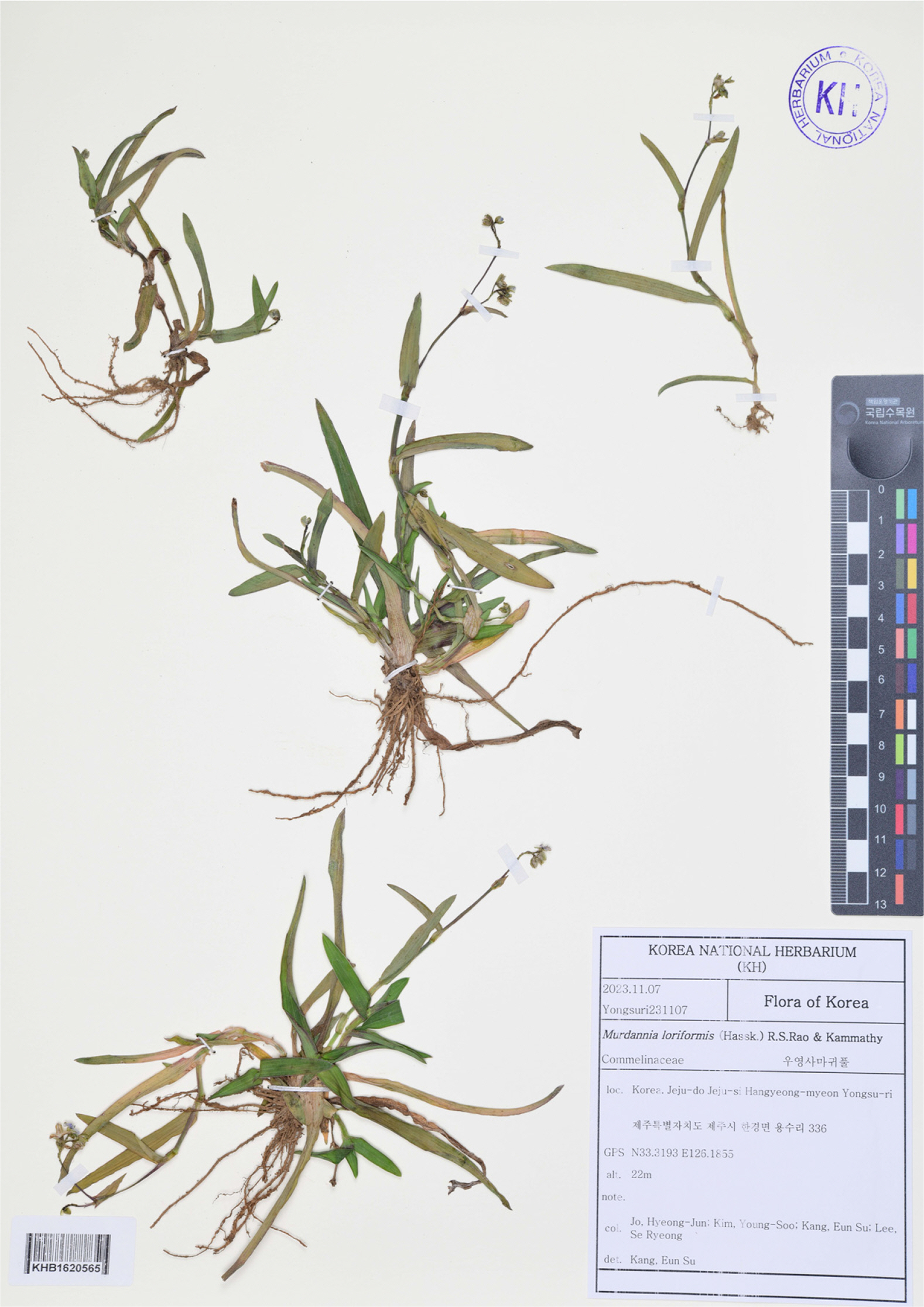
Fig. 2.
Photographs of Murdannia loriformis. A. Plant. B. Shoots. C. Sheath. D. Leaf. E. Inflorescence. F. Flower. G. Fruits and seeds. H. Seeds. 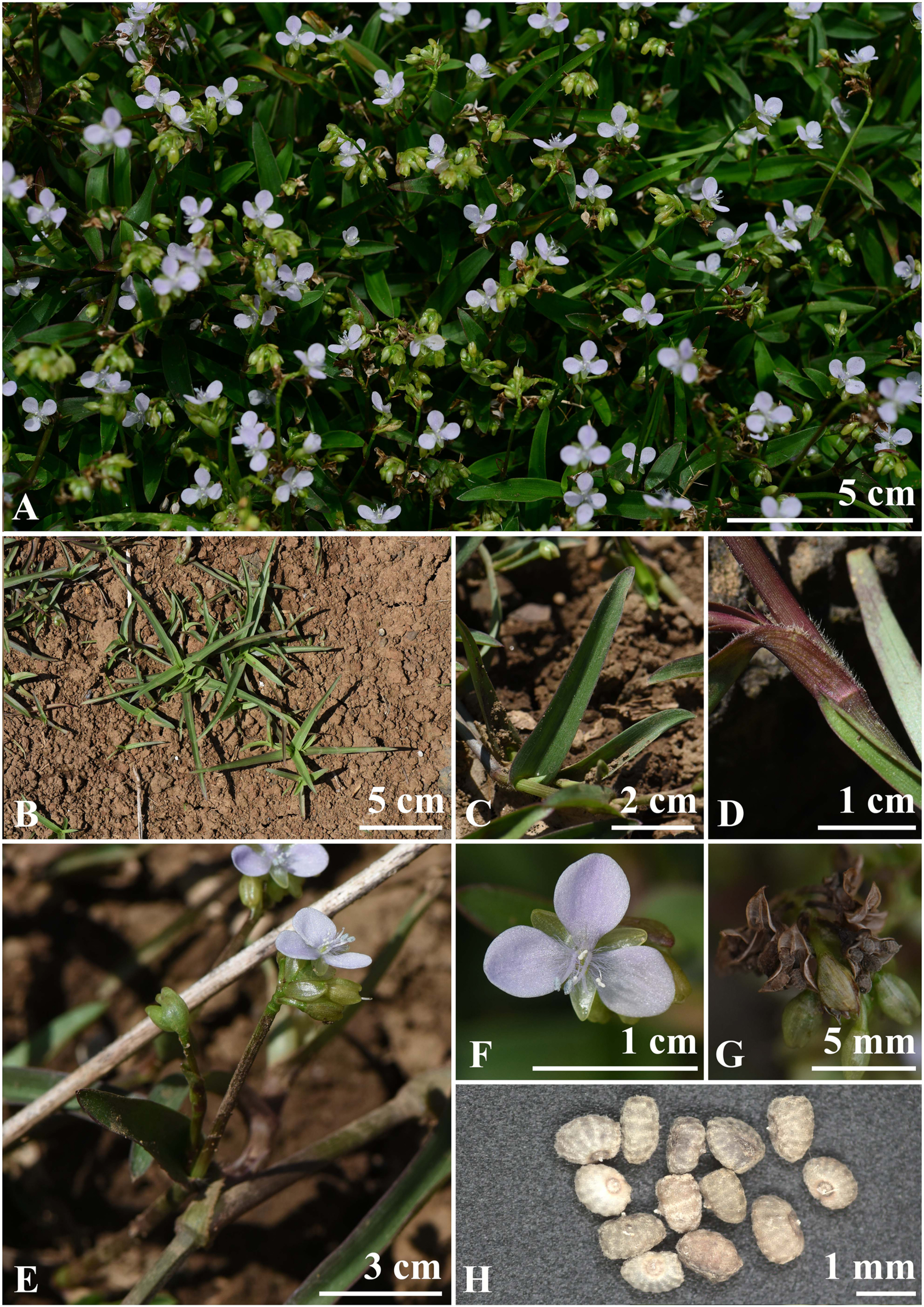
Fig. 3.
Voucher specimen of Murdannia nudiflora (KH). 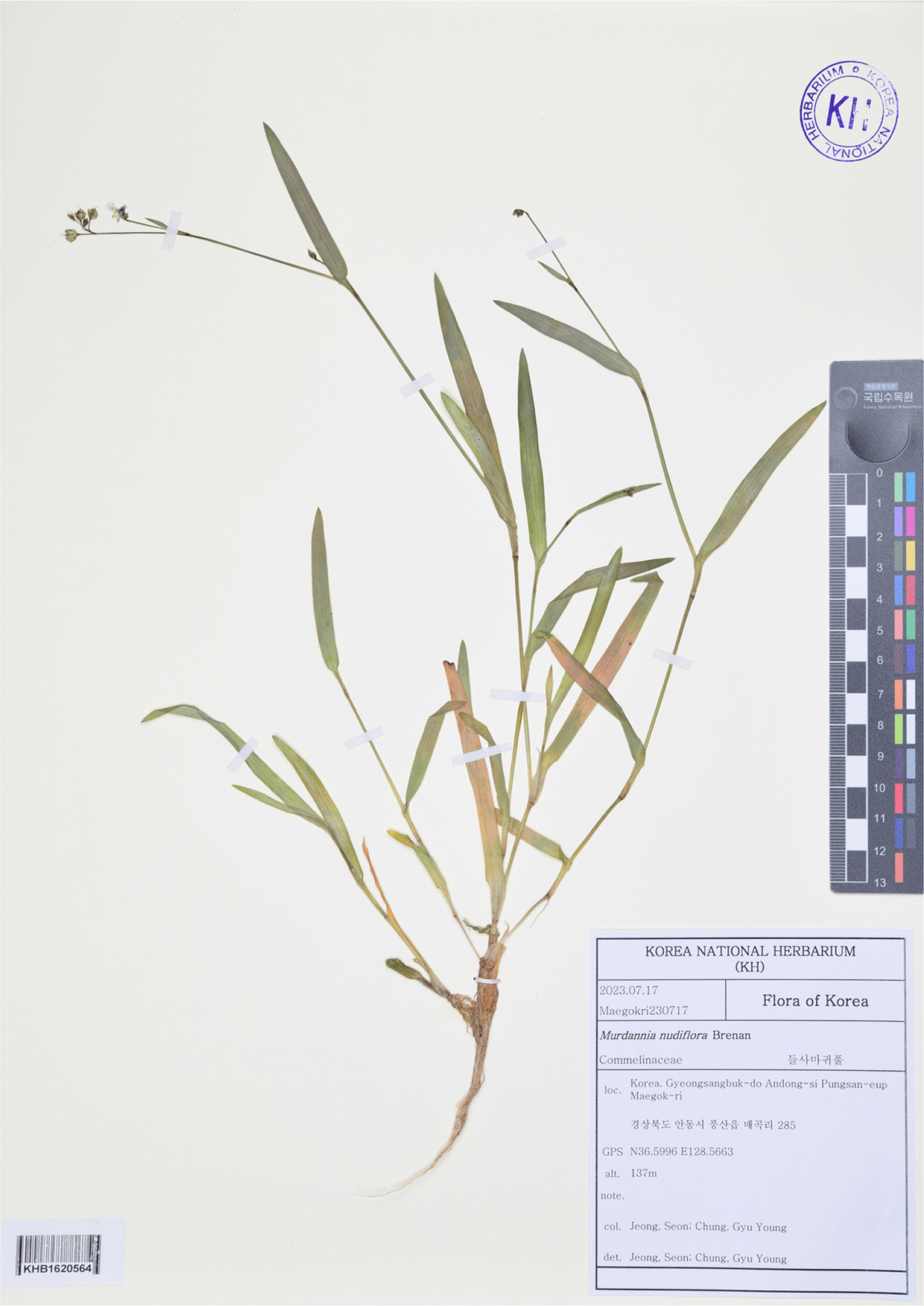
Fig. 4.
Photographs of Murdannia nudiflora. A. Plant. B. Shoots. C. Sheaths. D. Leaf. E. Inflorescence. F. Flower. G. Fruits and seeds. H. Seeds. 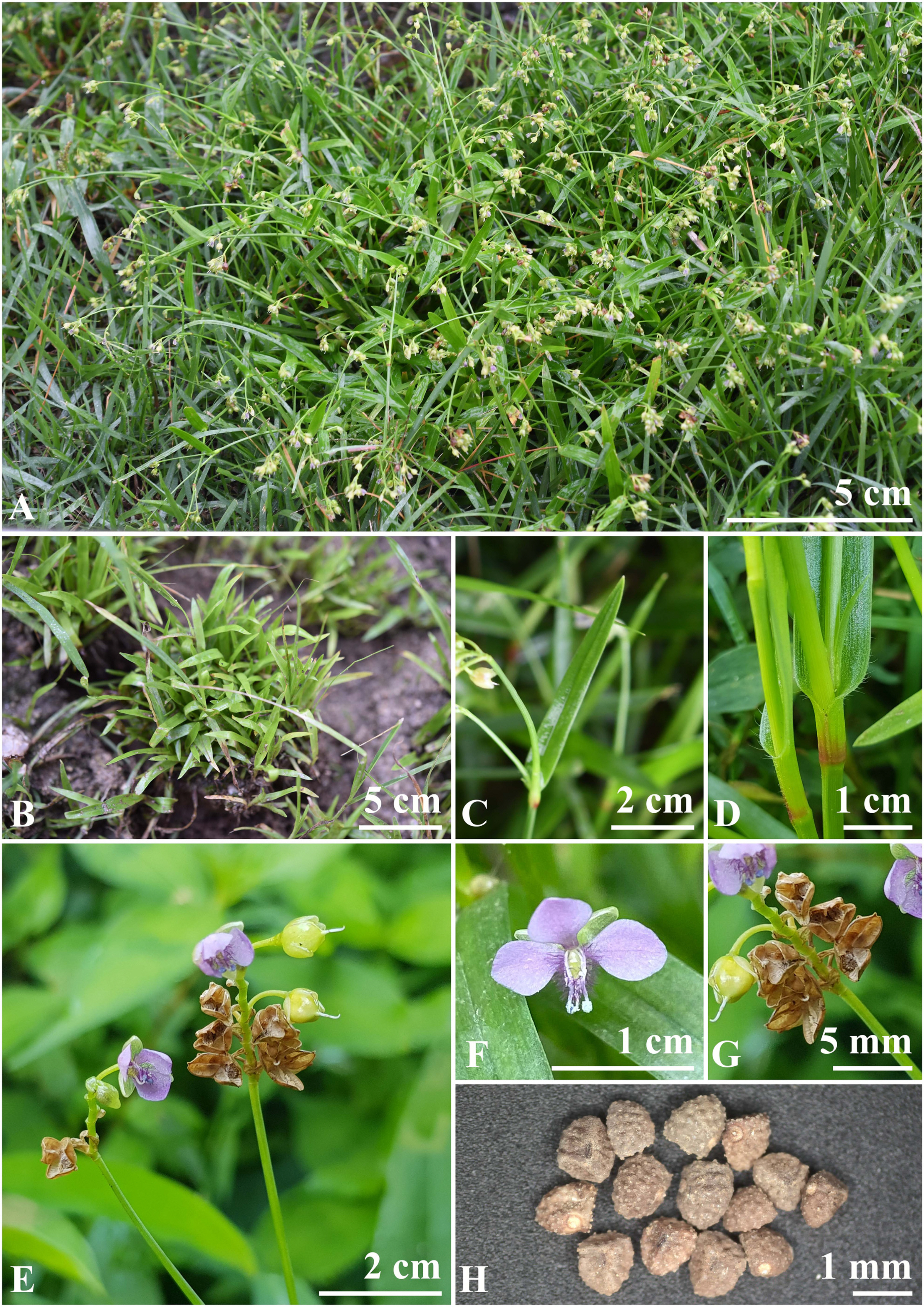
Fig. 5.
Comparison of the morphological characteristics for Murdannia loriformis and M. nudiflora. On the left is M. loriformis (A, stem and basal leaves; B, inflorescence; C, illustration of whole plant; D, seeds), and on the right is M. nudiflora (E, basal stem and leaves; F, inflorescence; G, illustration of whole plant; H, seeds). 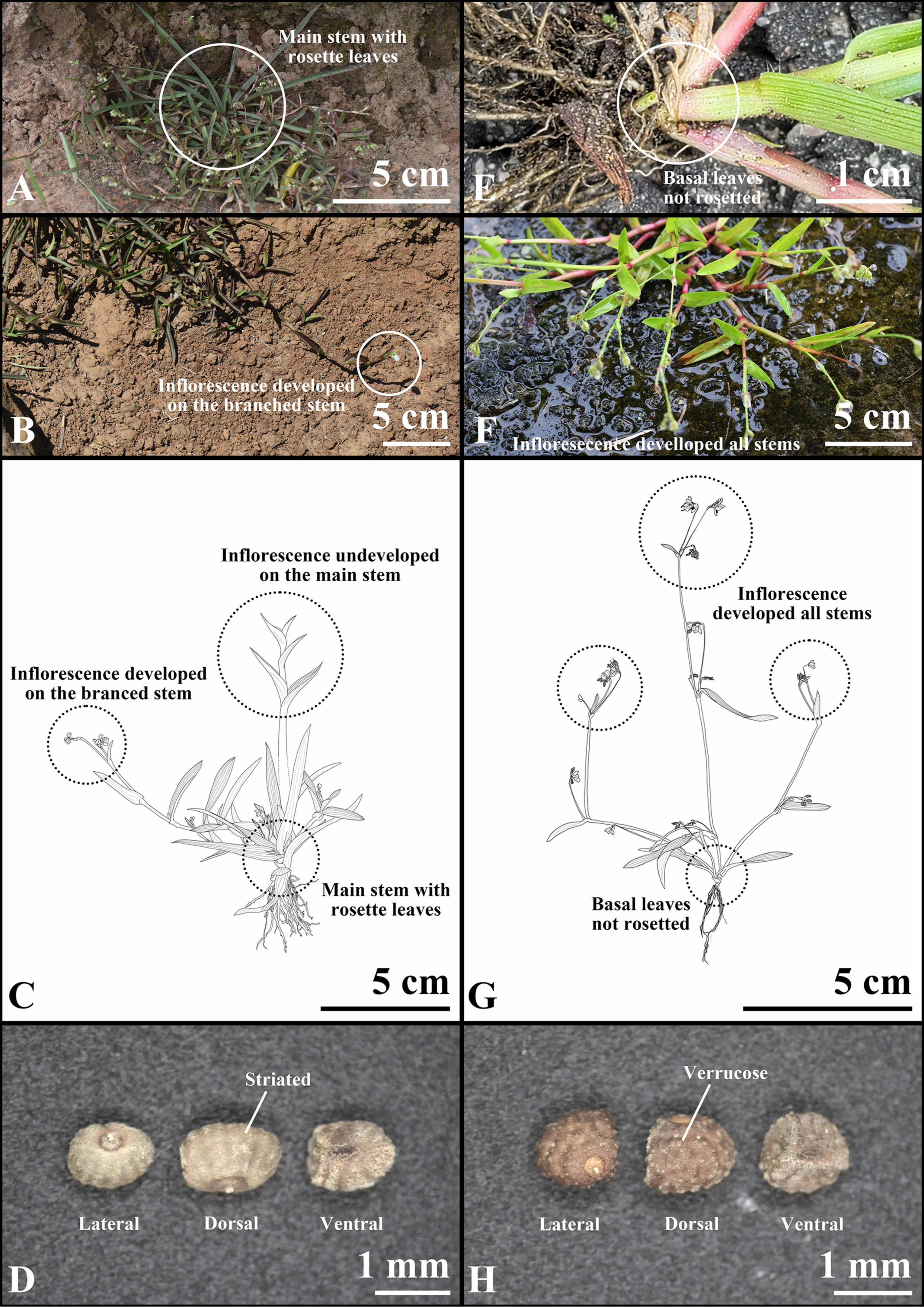
Fig. 6.
Distribution map of Murdannia loriformis and M. nudiflora in South Korea. 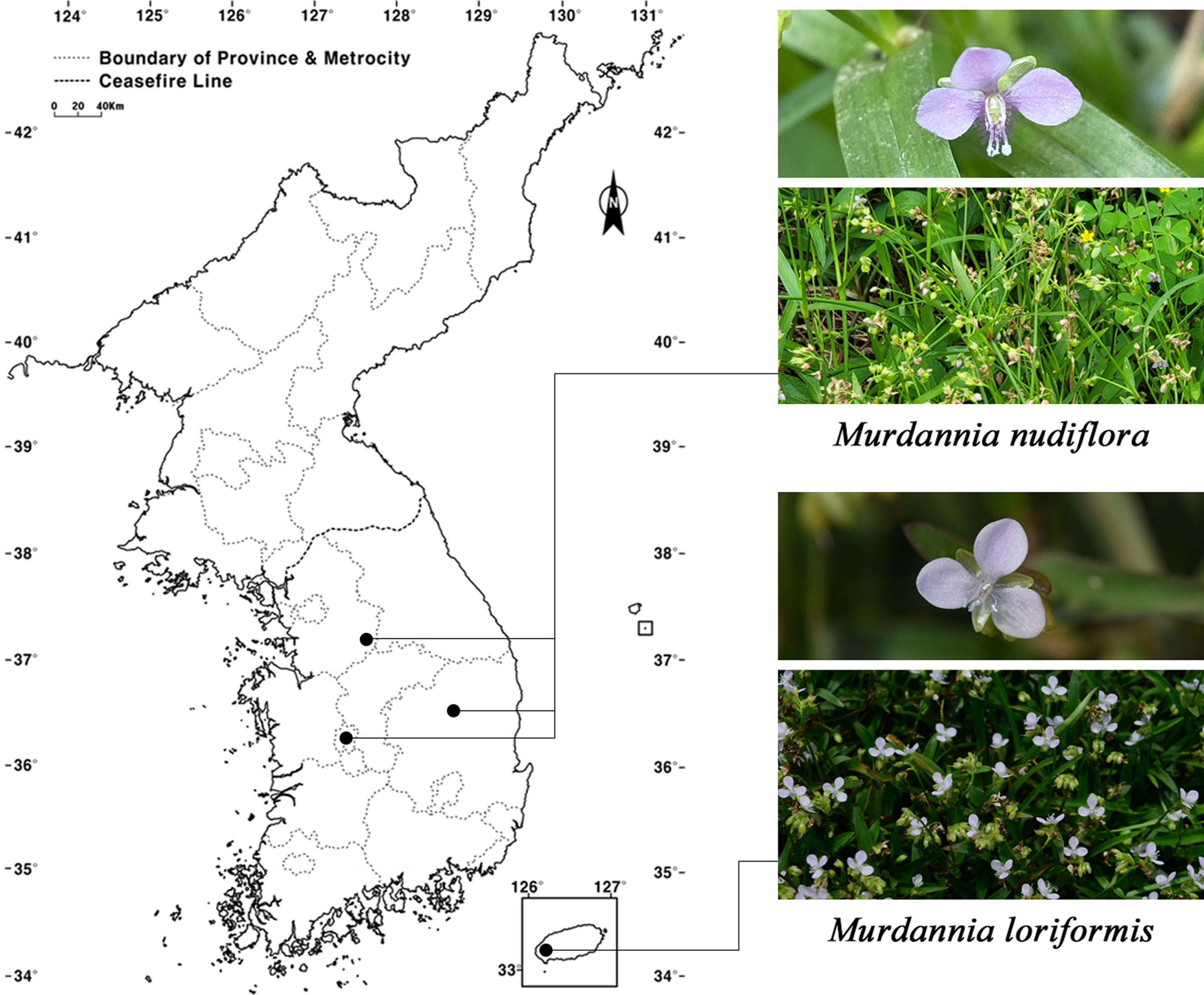
Table 1.
Comparison of the major characteristics of Murdannia loriformis, and M. nudiflora.
|
Character |
M. loriformis
|
M. nudiflora
|
|
Main stem |
developed |
undeveloped |
|
Basal leaves |
rosetted |
rarely 1–2 leaves, not rosetted |
|
Leaves |
|
|
|
length (cm) |
2.5–7.3 |
1.5–10 |
|
width (cm) |
0.4–1.5 |
0.3–1.2 |
|
margin |
usually undulate |
flattened |
|
Inflorescence |
developed only on the branched stems |
developed all stems |
|
Flower |
|
|
|
Petals color |
white to pale pink |
pink to purple |
|
Filament color |
white to pale pink |
pink to purple |
|
Fruit |
|
|
|
length (mm) |
3.2–3.8 |
3.2–4.0 |
|
width (mm) |
2.3–3 |
2.1–3 |
|
Seed testa surface |
foveolate-reticulate, striate, verrucose absent |
foveolate-reticulate, pitted, verrucose |
LITERATURE CITED
Ancy, A. A. 2014. Taxonomic revision of the genus Murdannia Royle (Commelinaceae) in India. PhD dissertation,. Calicut University, Kerala, India. Pp. 343 pp.
Ancy, A. A., Veena, V. and Nampy, S. 2015. Lectotypification of ten species of Murdannia Royle (Commelinaceae). International Journal of Plant, Animal and Environmental Sciences 5: 42-49.
Brenan, J. P. M. 1952. Notes on African Commelinaceae. Kew Bulletin 7: 179-208.  Brenan, J. P. M. 1966. The classification of Commelinaceae. Journal of the Linnean Society of London, Botany 59: 349-370.  Faden, R. B. 1998. Commelinaceae. Flowering Plants Monocotyledons: Alismatanae and Commelinanae (Except Gramineae). 4: Kubitzki, K. (ed.), Springer Verlag, Berlin. Pp. 109-128.  Fukuoka, N. and Iwatsuki, K. 2016. Flora of Japan. 4b: Iwatsuki, K., Boufford, D. E. and Ohba, H. (eds.), Kodansha, Tokyo. Pp. 46-51.
Hong, D. and DeFilipps, R. A. 2000. Commelinaceae. Flora of China. 24: Wu, Z. Y. and Raven, R. H. Science Press, Beijing and Missouri Botanical Garden Press, St. Louis, MO. Pp. 39-133.
Kang, E. S., Kim, C. W. Son, D. C. Yim, M.-Y. and Ji, S.-J. 2023. Ipomoea heptaphylla and Murdannia nudiflora: New records for the flora of Korea. Korean Journal of Plant Taxonomy 53: 222-229.
Lee, N. S. 2007. Commelinaceae. The Genera of Vascular Plants of Korea. Flora of Korea Editorial Committee (ed.), Academy Publishing Co., Seoul. Pp. 1098-1101.
Nakamura, I. 2015. Murdannia nudiflora (Commelinaceae), a new naturalized species to Japan. Journal of Japanese Botany 90: 215-217.
Pellegrini, M. O. O., Faden, R. B. and Almeida, R. F. 2016. Taxonomic revision of Neotropical Murdannia Royle (Commelinaceae). PhytoKeys 74: 35-78.
Ramana, M. V., Nandikar, M. Gurav, R. V. Tagore, J. K. and Sanjappa, M. 2013. Murdannia saddlepeakensis (Commelinaceae): A new species from Andaman and Nicobar Islands, India. PhytoKeys 20: 9-15.  Sulaiman, I. S. C., Mohamad, A. and Ahmed, O. H. 2021. Murdannia loriformis: A review of ethnomedicinal uses, phytochemistry, pharmacology, contemporary application, and toxicology. Evidence-Based Complementary and Alternative Medicine 2021: 9976202.  
|
|

















